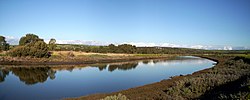Onkaparinga River: Difference between revisions
rewrite content to clarify that the listed protected areas are within the catchment area rather than the opposite |
Add new opening sentence to clarify where the river is located. |
||
| Line 15: | Line 15: | ||
}} |
}} |
||
The '''Onkaparinga River''' runs from its source between [[Mount Torrens]] and [[Charleston,_South_Australia|Charleston]] in the [[Mount Lofty Ranges]], and flows south westerly to an estuary at [[Port Noarlunga]]. The catchment is over {{convert|500|km2|abbr=0}} in area, and in part includes the following [[protected area]]s - the [[Onkaparinga River National Park]] and the [[Onkaparinga River Recreation Park]]. |
The '''Onkaparinga River''' is a [[river]] located in [[South Australia]] south of the [[Adelaide city centre]]. It runs from its source between [[Mount Torrens]] and [[Charleston,_South_Australia|Charleston]] in the [[Mount Lofty Ranges]], and flows south westerly to an estuary at [[Port Noarlunga]]. The catchment is over {{convert|500|km2|abbr=0}} in area, and in part includes the following [[protected area]]s - the [[Onkaparinga River National Park]] and the [[Onkaparinga River Recreation Park]]. |
||
The Onkaparinga River is the second major river of the [[Adelaide]] region, after the [[River Torrens]]. The name derives from the Indigenous [[Kaurna people|Kaurna]] name Ngangiparri which translates as "The Women's River". |
The Onkaparinga River is the second major river of the [[Adelaide]] region, after the [[River Torrens]]. The name derives from the Indigenous [[Kaurna people|Kaurna]] name Ngangiparri which translates as "The Women's River". |
||
Revision as of 06:27, 15 May 2015
This article needs additional citations for verification. (May 2015) |
| Onkaparinga River | |
|---|---|
 | |
| Physical characteristics | |
| Mouth | Port Noarlunga South & Port Noarlunga |
| Length | 95 kilometres (59 mi)* |
The Onkaparinga River is a river located in South Australia south of the Adelaide city centre. It runs from its source between Mount Torrens and Charleston in the Mount Lofty Ranges, and flows south westerly to an estuary at Port Noarlunga. The catchment is over 500 square kilometres (190 sq mi)* in area, and in part includes the following protected areas - the Onkaparinga River National Park and the Onkaparinga River Recreation Park.
The Onkaparinga River is the second major river of the Adelaide region, after the River Torrens. The name derives from the Indigenous Kaurna name Ngangiparri which translates as "The Women's River".
In 1837 Surveyor General Col William Light named it Field's River, or the Field River, after Lieut William George Field RN (1804-1850) of the brig Rapid, who carried out the first surveys in the vicinity of its estuary, but subsequent Governor George Gawler soon reinstated the Indigenous name. The first Europeans to explore its sources and the Onkaparinga Valley were the party of Dr. George Imlay and John Hill in January 1838.[1]
It is a source of fresh water for the city of Adelaide. Mount Bold Reservoir was constructed between 1932 and 1938 along a section of its path approximately 20 kilometres (12 mi)* inland. Much of its flow is diverted via a tunnel from the Clarendon Weir to the Happy Valley Reservoir, that in turn supplies some 40 per cent of Adelaide's water supply. Most years the flow to the reservoir is supplemented by water pumped from the River Murray via a pipeline from Murray Bridge.
Downstream from Mount Bold Reservoir is the Clarendon Weir. To maintain levels at Clarendon Weir, water is released only as required. The Onkaparinga Gorge extends from Clarendon to Old Noarlunga. An estuary extends from Old Noarlunga to the river's mouth between the suburbs of Port Noarlunga and Port Noarlunga South. The estuary is a significant breeding area for local marine fish species.
The Coast to Vines rail trail crosses over the river just west of where Main South Road crosses over. The Seaford railway line passes over the park on a 1.2 km (0.75 mi) elevated bridge (known as the Onkaparinga Valley Bridge) which was built between 2011 and 2014.[2]

References
- ^ The Colonist, 7 March 1838, p. 2.
- ^ "Seaford rail extension bridges" (PDF). Department of Transport Energy and Infastructure. Retrieved 4 April 2014.
